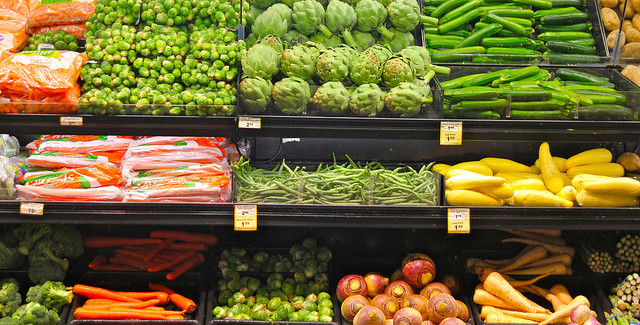
Eat Your Veggies!
We all know we need more fruits and veggies in our diets, but the task can seem somewhat daunting at first. What’s a serving size? Which colors do I need to eat? Does this count as a vegetable? What about juice? What’s the best way to prepare veggies? Isn’t it going to be expensive? How can I make vegetables taste good? These are all valid questions that our resident RD, Sarah Downs, is here to answer.
How many vegetables do I need to eat each day?
Sarah Downs, RD: “It depends on the age, activity level and gender, but ranges from one cup to three cups per day. Generally, one cup of raw or cooked vegetables or vegetable juice or two cups of raw leafy greens can be considered as one cup from the vegetable group. For additional information on serving sizes and recommendations per age group, Choose MyPlate is a great resource.”
What are the best types of vegetables to eat?
Sarah Downs, RD: “Any vegetable or 100 percent vegetable juice counts as a member of the vegetable group. Veggies can be raw or cooked, fresh, frozen, canned or dried and may be whole, mashed or cut. Based on their nutrient content, vegetables are organized into five subgroups:
- dark green vegetables
- starchy vegetables
- red and orange vegetables
- beans and peas
- other vegetables
It is a good idea to choose a variety of vegetables from the different groups above because they offer distinctive nutrients and health benefits.”
What makes a vegetable a vegetable and not a fruit (i.e., tomatoes)?
Sarah Downs, RD: “From a botanist’s (someone who studies plants) point of view, fruits are the part of the plant that develops from a flower and contains the seeds. Vegetables are the other part of the plant — this includes the stems, leaves and roots. From a culinary point of view, vegetables are less sweet and fruits are typically sweeter and more tart. When it comes to nutrition, fruits and vegetables are similar in that they are typically low in calories, high in fiber and antioxidants and loaded with vitamins and minerals.”
Does vegetable juice count?
Sarah Downs, RD: “It is best to eat the whole vegetable because of the insoluble fiber it provides. However, vegetable juice is okay to consume as one to two servings of vegetables. It is important you choose 100 percent vegetable juice and be mindful of the sodium content in some of the veggie juices.”
What’s the best way to prepare vegetables?
Sarah Downs, RD: “Any technique is great, except for deep frying or adding calorie-dense cream/cheese sauces. Whatever way you choose to cook veggies (boil, bake, microwave, or even raw) is fine, as long as you are eating plenty of vegetables to begin with. By experimenting with different techniques, you may be able to find the ways you enjoy them best!”
Are fresh veggies better than frozen or canned?
Sarah Downs, RD: “When fresh vegetables are consumed in season, they often may taste better to some, but when it comes to nutrition they are the same. In fact, many times frozen vegetables are flash frozen at their peak ripeness so their nutrient content may be slightly higher than fresh vegetables. The benefits of frozen and canned vegetables is that they are affordable even when they are out of season and you will still get the same amount of nutrients. It is important to read the label and look at the amount of sodium in canned vegetables. There are many varieties that are low sodium; if not, you can rinse your canned beans and veggies to remove some of the sodium.”
There is no “one size fits all” approach to consuming fruits and vegetables, and it’s great to have the choice of whether to purchase fresh, frozen or canned. Check out some additional information on this topic:
- Fresh, Frozen, Canned, Dehydrated: Healthy Eating Year-Round
- Are Fresh Fruits and Vegetables Better than Canned or Frozen Produce?
I’m on a budget but want to eat more vegetables. How do I do that?
Sarah Downs, RD:
- Buy in season: While most vegetables are available year-round, some are less expensive when they are in season. Also, remember that all forms of fruits and vegetables are nutritious. Canned and frozen can be budget-friendly options to consider.
- Buy more: When there are specials, buy extra. They can be frozen to use later or used in a dish that can be frozen for later.
Vegetables don’t taste good to me. How can I enhance the flavor and make them more enjoyable for me to eat?
Sarah Downs, RD:
- Pair with cheese. A sprinkle of Parmesan or mozzarella cheese usually does the trick.
- Get tangy and add a splash of citrus juice on top. Lemon is my favorite!
- Experiment with different types of herbs and spices.
- Turn up the heat by adding a chopped jalapeno pepper or red chili flakes to your next dish.
- Stuff your veggies. Bell peppers, mushroom caps, tomatoes and artichokes are perfect for stuffing, baking and roasting. I like to stuff veggies with ground beef or turkey, rice and black beans for a protein-and veggie packed-entree!
What’s your favorite vegetable?
Sarah Downs, RD: “My favorite vegetable is raw carrots — I love the crunch!”
The image “Vegetables” by Daniel Cukier is licensed under CC BY ND 2.0.


























